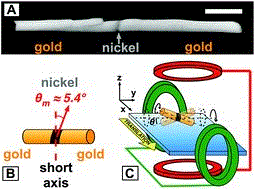The article appearing in Nanoscale describes research by a team including Associate Professor of Physics Benjamin Evans into the behavior of a microscale swimming device controlled with magnetic fields.
New research published by a team including Elon Associate Professor of Physics Benjamin Evans demonstrates how a “microkayak” can be manipulated by magnetic forces to transport a single cell or mix liquids at the microscopic level.
 The findings are laid out in “Magnetic microkayaks: propulsion of microrods precessing near a surface by kilohertz frequency, rotating magnetic fields,” an article available in the February issue of the peer-reviewed journal Nanoscale. The work was performed in collaboration with researchers at Weinberg Medical Physics, Inc.
The findings are laid out in “Magnetic microkayaks: propulsion of microrods precessing near a surface by kilohertz frequency, rotating magnetic fields,” an article available in the February issue of the peer-reviewed journal Nanoscale. The work was performed in collaboration with researchers at Weinberg Medical Physics, Inc.
As biophysicists dive deeper into single-molecule and single-cell experiments, it has become essential to develop mechanisms by which they can precisely and predictably manipulate microscopic matter. Nano- and microscale magnetic materials are an attractive option for doing so, since they allow non-contact interaction with the materials using macroscale magnetic fields.
In this manuscript, Evans and colleagues demonstrate magnetic control over a 5-micron-long gold and nickel rod. The configuration of the magnetic nickel component enables a novel type of motion that has never before been accomplished with magnetic micromaterials: the rod describes a double-cone rotation much like a kayaker’s paddle, and this motion allows the rod to “swim” through a fluid. The speed and direction of the swimming can be finely-controlled by the experimenters.
Evans and colleagues demonstrate that these magnetic microswimmers can be used to capture and transport a payload, such as a single cell. In addition, the kayaking motion can be used to mix viscous fluids on a microscale, which is a key barrier to the continued development of lab-on-a-chip medical diagnostic devices.
Evans has conducted extensive research on the use of magnetic forces on micromaterials. Earlier this year, the National Science Foundation featured his research into how the use magnetic devices to control soft robots on its Science360 News website.


